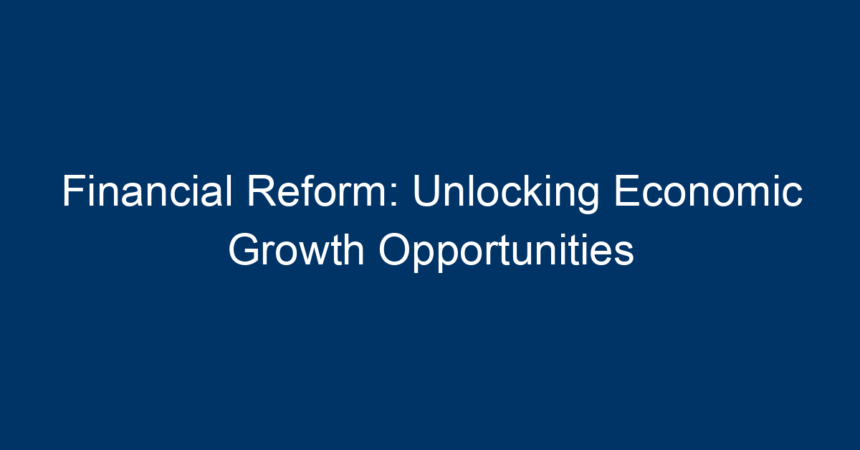In a rapidly evolving global economy, the call for financial reform is more pressing than ever. As financial institutions and markets become increasingly complex, the need for a framework that promotes transparency, stability, and growth is essential. This article delves into the landscape of financial reform, exploring its significance in unlocking economic growth opportunities, examining successful case studies, and offering actionable insights for policymakers, investors, and citizens alike.
Understanding Financial Reform
Financial reform encompasses a series of regulatory changes designed to improve the functioning of financial markets. These reforms aim to address systemic risks, enhance consumer protections, increase access to capital, and promote overall economic stability. By streamlining financial operations and enforcing strict compliance measures, countries can create a healthier economic environment ripe for growth.
The Importance of Financial Reform
-
Stability in Financial Markets
One of the primary objectives of financial reform is to establish a stable economic environment. Markets that operate with transparency are less susceptible to crises caused by misinformation or fraudulent activities. Take the 2008 financial crisis as an example; it underscored the global repercussions of inadequate regulations and lax oversight. -
Enhancing Public Trust
A transparent financial system builds public confidence. When citizens trust that their investments are secure and that their financial institutions are well-regulated, they are more likely to invest and save, fueling economic growth. - Access to Capital
Financial reform can enhance access to capital for small and medium-sized enterprises (SMEs). By simplifying loan processes and ensuring fairness in lending practices, financial institutions can provide more opportunities for budding entrepreneurs to enter the market, paving the way for innovation and job creation.
Key Components of Effective Financial Reform
Successful financial reform initiatives often include several interrelated components that work in harmony to promote economic growth. Here are some essential elements:
Regulatory Framework
A comprehensive regulatory framework is crucial. This includes creating clear guidelines that financial institutions must follow, ensuring accountability, and establishing a robust oversight body to monitor compliance.
Consumer Protection
Stronger consumer protection laws prevent predatory lending practices and improve transparency in financial products. When consumers are empowered with knowledge and safeguards, they can make better financial decisions.
Financial Education
Financial literacy plays a vital role in advocating for financial reform. Educating the public about personal finance and investment can enhance individual capabilities while reducing systemic risks associated with uninformed financial decisions.
Technological Innovation
Leveraging technology can facilitate financial reform. Fintech solutions streamline processes, reduce costs, and improve accessibility. From blockchain technology to mobile banking, adopting new technologies can help transform the financial landscape.
Successful Case Studies of Financial Reform
Learning from successful financial reform case studies can provide invaluable insights for other nations. Let’s examine a few notable examples:
1. The Dodd-Frank Act (USA)
Passed in response to the 2008 financial crisis, the Dodd-Frank Wall Street Reform and Consumer Protection Act aimed to promote financial stability and protect consumers. It established the Consumer Financial Protection Bureau (CFPB), which enforces regulations around lending practices. Although controversial, the act has significantly improved consumer protections and increased transparency in the financial system.
2. The European Union (EU) Financial Regulatory Reforms
The EU implemented extensive financial reforms following the eurozone crisis. These measures included the establishment of the European Banking Authority, aimed at ensuring effective regulation and oversight of the banking sector, as well as the introduction of stress tests to assess the resiliency of banks. The reforms have contributed to increased market confidence and stability across member states.
3. The Financial Sector Deepening Initiative (Africa)
In several African countries, the Financial Sector Deepening (FSD) initiative has successfully promoted financial inclusion. By fostering innovation in the banking sector and focusing on the needs of low-income populations, the initiative has highlighted the benefits of inclusive financial practices. Nations that embraced these reforms have experienced substantial economic growth and poverty reduction.
The Role of Stakeholders in Financial Reform
The successful implementation of financial reform relies on the collaborative efforts of various stakeholders:
Government Entities
Governments play a crucial role in establishing the regulatory framework and ensuring that institutions adhere to the rules. Policymakers must prioritize transparency and public welfare in their decision-making processes.
Financial Institutions
Banks and other financial institutions must integrate reform initiatives into their operations, promoting better practices and ethical standards. Commitment to compliance not only builds trust but also enhances the institution’s reputation.
Consumers
Consumers should actively participate in advocating for better financial practices. By becoming informed about their rights and responsibilities, they can hold financial institutions accountable and drive demand for reform.
NGOs and Advocacy Groups
Non-governmental organizations can play an essential role in influencing policy changes and raising awareness about consumer needs and vulnerabilities. Their advocacy is vital to ensuring that reforms are inclusive and equitable.
Challenges to Financial Reform
While the potential benefits of financial reform are clear, challenges often arise during implementation. Here are a few obstacles to consider:
-
Political Resistance
Financial reform can encounter pushback from political entities aligned with certain financial interests. Effective advocacy and public support are necessary to counteract this resistance. -
Information Asymmetry
Both consumers and financial institutions may lack access to the necessary information to make informed decisions. Ensuring that information is readily available and understandable can help reduce this gap. - Global Coordination
Given the interconnectedness of global markets, unilateral reforms may lead to unintended consequences. Countries must strive for international cooperation to ensure comprehensive and effective reforms.
Actionable Insights for Effective Financial Reform
For those invested in the promotion of financial reform, here are some actionable insights to consider:
-
Advocate for Transparent Policies
Engage with policymakers to promote transparency in financial regulations. Advocate for reforms that prioritize consumer protection, stability, and market efficiency. -
Invest in Financial Education Programs
Support initiatives aimed at enhancing financial literacy in communities. Providing access to educational resources can empower individuals to make informed financial decisions. -
Embrace Technology
Leverage technological advancements to promote efficient financial practices. Encourage financial institutions to adopt innovative solutions that enhance service delivery and customer experience. - Foster Inclusivity
Ensure that reforms prioritize the needs of underrepresented groups, particularly those who may lack access to traditional financial services. Focus on inclusive practices that enhance economic opportunities for all.
Conclusion
Financial reform is not merely a regulatory necessity—it’s a critical driver of economic growth. By understanding its importance, identifying successful case studies, and recognizing the roles of various stakeholders, we can pave the way for a robust financial future. The transformation of financial systems through well-thought-out reforms can unlock numerous economic opportunities, benefiting individuals and communities alike. Together, let us advocate for reforms that foster transparency, innovation, and inclusivity, ensuring a brighter financial landscape for future generations.




